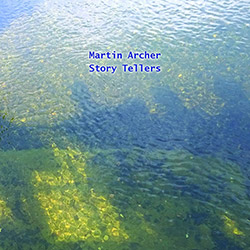
Yet another case of jazz-rooted-yet-nearly-impossible-to-categorize release, requiring open-mindedness and dedication (read: time) to ascertain its many values.
Reedist and composer Martin Archer was aided by the sympathetic companionship of Mick Somerset on additional wind instruments and percussion, Kim Macari Stone-Lonergan on trumpet, Corey Mwamba on vibraphone, Anton Hunter on guitar and Peter Fairclough on drums. Although every musician is the owner of an excellent CV, this is not the sort of setting urging an audience to single out voices. It's instead a collective effort of the genuine kind, a man's idea interpreted with care for the detail and — let's use the word for once — love for the music they're playing.
Verbally synthesizing a work whose conceptual depth morphs into acoustic intelligibility is quite an arduous task. This clarity is rather remarkable given that these 150 minutes represent the ensemble's recording debut as it happened, except for a modicum of editing. The accurateness informing the performance — directly proportional to the perceived earnestness — suggests a considerable quantity of rehearsals before committing everything to tape.
If so, those sessions paid dividends. The sonic anatomy of Story Tellers escapes from immediate memorization; on the other hand, its ancestry is recounted most everywhere and substantiated by the very players via carefully disseminated homage. But if an adjective can be be used to identify the whole, it's "balanced". Meaning that there isn't a note out of place; that the dissonant ramifications find a correspondence with the quieter sections; that massive respect is shown by the musicians, whose faultless rendering of Archer's vision — not to mention their improvisational insight — is improved by brilliant mixing and mastering. All in all, a complete package.
Often the term "jazz" is really too reductive to differentiate a record. Perhaps the lone authentically "jazz" constituent here is the common ground from which the unscripted wisdom of the individual characters develops. A necessity always arises for a player to follow his/her instinctive spontaneity; since those tendencies are encouraged by a score allowing ample spaces to solitariness, the results are gladdening while respecting the correct articulation/disorder ratio. In this sense, Archer revealed himself to be an outstanding architect.
Never does the variability of stylistic tones produce a "sounds like..." response. One does recognize a thematic continuity; appreciates the concatenation of simple melodic cells, the slight variations and the abrupt u-turns; rejoices for the unquestionable quality of the interplay and the pureness of the resulting sonority. The design behind the unfolding scenes becomes clearer with subsequent listens, timbral refinement and melodically advanced geometry weighing the same as a distorted guitar emitting feedback or comping with introvert clusters.
As Duncan Heining correctly noted in All About Jazz, the structure of this important chapter in Archer's career may recall a concept album from the 70s. From my point of observation, this is a major plus. However, this writer's favorite image for Story Tellers is that of a finely crafted model of a vessel, each new look bringing the discovery of previously unnoticed particularities.
Comments and Feedback:
| 


